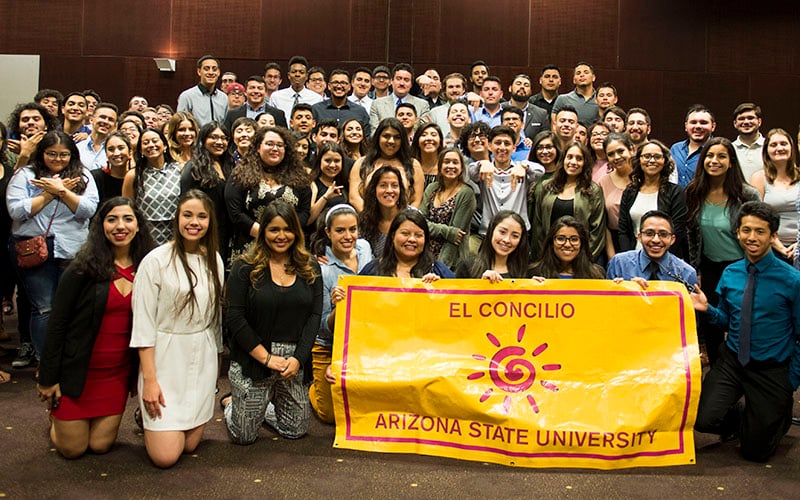
Members of El Concilio, an on-campus coalition that represents the Latino, Chicano and Hispanic community at Arizona State University, gather prior to a banquet on March 30 to celebrate 25 years at the school. (Photo by Ryan Santistevan/Cronkite News)
For 25 years, one coalition has worked to unite Latino, Chicano and Hispanic student organizations at Arizona State University.
El Concilio aims to give special recognition to the leadership of its organizations, students and faculty. Its mission is to advocate, celebrate, and educate the community on Hispanic, Latino and Chicano culture.
Last month the coalition gathered at a banquet to celebrate its 25th anniversary. The event was open to all members of the organization. It included food, music, and special recognition to member organizations, students and a professor who rightly celebrated the coalition’s mission.
Coalition Vice President Luis Martinez-Mella, a junior majoring in business and technology innovation at ASU, said if it wasn’t for this collaboration he doesn’t think he would be in college. The transition from family to a campus full of people who didn’t look or act like him made him uncomfortable, he said.
“I’m a first generation Latino,” Martinez-Mella said. “It was hard. Being away from family, being in a foreign area. It was also the first time that I really noticed people weren’t exactly like me.
“Being on a campus that’s like 50,000 students where the majority don’t look like you and don’t understand some of the intersectionality and struggles you go through, that was rough and it did take a toll on me,” he said
Martinez-Mella said each member in El Concilio feels a sense of familia (family) in the coalition because they are able to connect with other organizations.
Members of the coalition include Association of Latino Professionals for America at ASU, Society of Hispanic Professional Engineers, Teatro Diablo, Chicano-Latino Law Student Association and more than 20 other organizations. Ten students represent the board of El Concilio.
Angelica Rodriguez, president of the coalition, is a junior majoring in business management at ASU. She said El Concilio also advocates to get its message out into the off-campus community.
“It is an organization that empowers, unites and strives for inclusion for all students residing at all four campuses,” she said.
One of the main initiatives it has achieved in the past five years is to help create programming for Hispanic Heritage Month.
The coalition was founded to unite all Latino, Chicano and Hispanic organizations at ASU, help with issues those students faced and for them to have a place to call home.
In 1991, the coalition was founded by member organizations. Rodriguez said it was founded because there was a lack of Latino, Chicano and Hispanic representation at ASU.
- The goals are threefold:
- Support the recruitment and retention of Chicano, Hispanic, Latino undergraduate and graduate students, faculty, staff and administrators;
- Act as a bridge between the Chicano/Hispano/Latino community;
- Create awareness about the community.
James Randall, advisor to El Concilio, is also the coordinator of student and cultural engagement, an advisor to the Black African Coalition, and temporarily an advisor to the American Indian Council. Since May 2015, Randall has been the direct advisor to El Concilio.
“I believe in everything being student-driven,” Randall said. “I come from the approach of bringing guidance and support as they need it. Being able to let them know about the resources at ASU, the resources in the community, and then serving as more of a facilitator, I can help bridge a gap between those resources on campus and in El Concilio.”
However, being advisor hasn’t been his first interaction with the coalition. He was a student member and president of Lambda Theta Phi Latin Fraternity, Inc., a member organization. He graduated from ASU with an anthropology degree in 2009.
Randall said the coalition’s growth is the biggest change in the organization. He said this is due to the fact that organizations are created over time. This year the Latino Architecture Student Organization was started.
“I think the biggest impact is how (El Concilio) enhances the cultural fiber at ASU,” Randall said. “The organizations create programs that help inform and educate the ASU population, as well as celebrate different identities.”